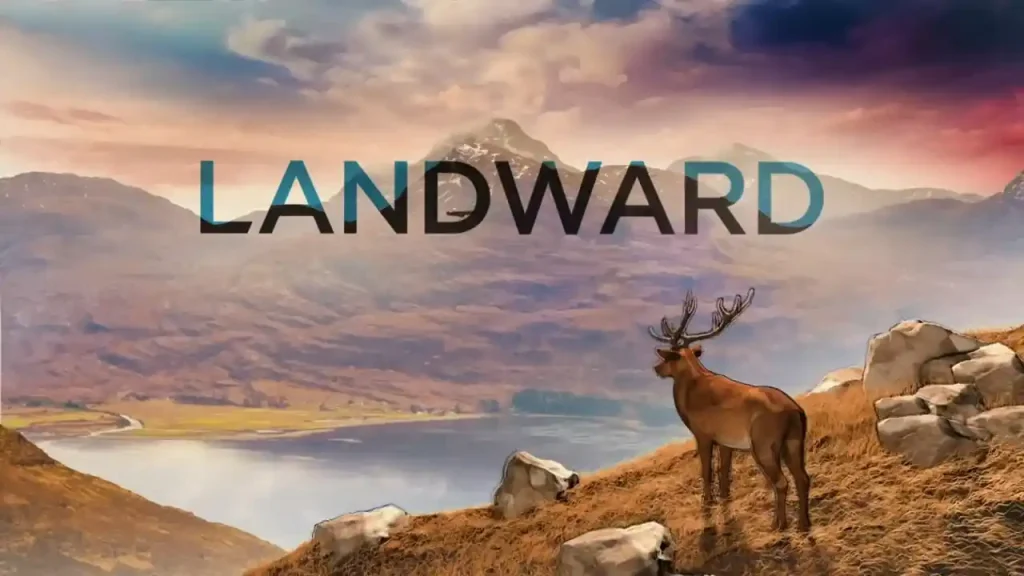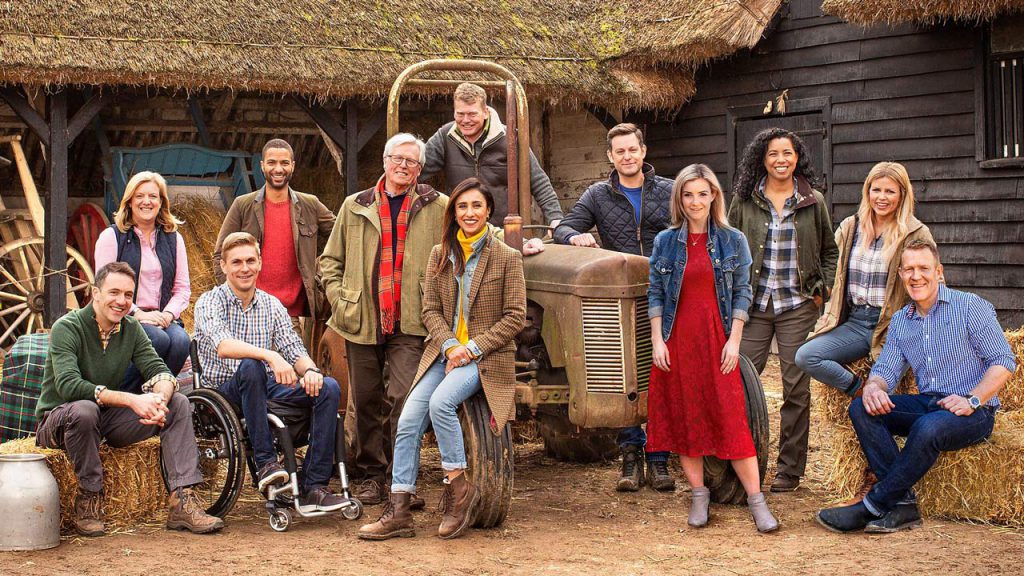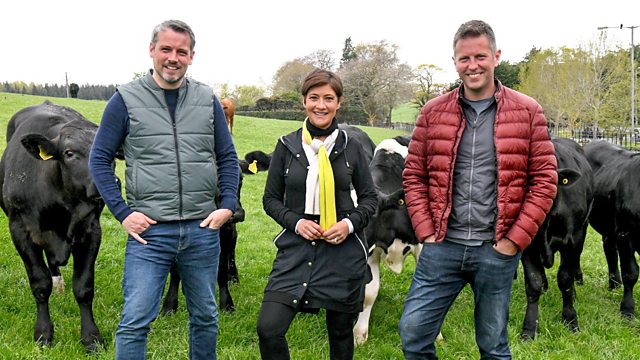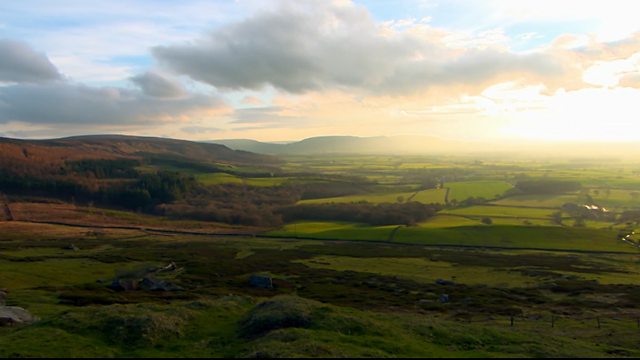Landward episode 15 2023 – In this captivating episode, join Dougie as he embarks on an enlightening journey to the Ben Lawers National Nature Reserve located in the picturesque Perthshire. Here, he uncovers the groundbreaking endeavors undertaken by the National Trust for Scotland. Witness the triumphant revival of a degraded hillside area that has been meticulously fenced off and nurtured back to health. Three decades later, the incredible transformation is unmistakably evident. The hillside is now teeming with lush trees, vibrant grasses, and a myriad of blooming flowers, painting a picture of rebirth and natural harmony.
As Dougie ascends further up the majestic mountain, he embarks on a quest tinged with urgency. The rare, delicate alpine plants that adorn the mountain’s slopes are in a sad retreat due to the escalating impacts of climate change. Join him as he navigates the rugged terrain in search of these beautiful, yet endangered botanical wonders, unveiling a story of resilience and survival amidst the changing climate. Meanwhile, journey alongside Anne to the breathtaking Angus coast as she commemorates the Scottish Geology Festival. With the staggering backdrop of immense sandstone conglomerate cliffs, Anne unveils the awe-inspiring tale of a gigantic Mississippi-sized river that once gracefully flowed across vast expanses of the land over a staggering 370 million years ago. Marvel at the geological wonders and the timeless narratives they hold within their ancient, eroded faces.
Venture further inland with Shahbaz on an exciting expedition to the renowned Balmoral Estate. Here, anticipation hangs in the crisp air as she hopes to glimpse the elusive capercaillie, a magnificent bird shrouded in mystery and allure. Lastly, accompany Rosie to the bustling Dingwall Mart. Amidst the vibrancy of autumn, the mart buzzes with activity, hosting their most hectic event of the year – the autumn lamb sales. Immerse yourself as Rosie delves into the intricate and thrilling work of an auctioneer, navigating the energetic atmosphere filled with eager anticipation and the resonating sounds of bids filling the air.
Landward episode 15 2023: A Scottish Countryside Adventure
Exploring the Rare Alpine Plants of Ben Lawers
The Ben Lawers National Nature Reserve is a special place. Nestled in the heart of Perthshire, this stunning mountain landscape is home to some of Scotland’s rarest alpine plants. In this episode of Landward, presenter Dougie Vipond journeys to Ben Lawers on a mission to track down these botanical treasures.
Dougie meets with experts from the National Trust for Scotland, who have been working tirelessly for decades to protect and restore the fragile alpine habitat. Thirty years ago, large swathes of the mountainside were damaged by overgrazing. The Trust took action, putting up fences to allow the vegetation to recover.
The transformation since then is remarkable. Lush grasses, heathers and wildflowers now cloak the hillsides in vibrant colors. Trees and shrubs have regenerated, providing shelter and food for wildlife. It’s a conservation success story, proving that with careful management, nature can rebuild itself from even severe degradation.
But threats still remain for Ben Lawers’ rarest inhabitants. Climate change is pushing alpine plants higher and higher up the mountain slopes in search of cooler conditions. Dougie joins botanists seeking out diminutive species like the starry saxifrage, tufted saxifrage and drooping saxifrage. These tiny flowers hug the ground in a bid to escape the wind and cold.
Seeing these tenacious plants clinging to existence, it’s clear they need our help. Protecting their habitat from grazing,erosion and trampling is vital. Recording exactly where species grow also helps inform conservation plans. Transplantation to more suitable sites may be an option for some.
The message is clear: Scotland’s upland ecology is intrinsically linked to its rarest wildlife. Places like Ben Lawers highlight the need for sensitive, tailored management. Working with nature, not against it, we can ensure this precious biodiversity continues to endure. For Dougie, it’s inspiring to see the Trust actively safeguarding that future.
Discovering Scotland’s Geological Wonders on the Angus Coast
While Dougie explores the mountains, co-presenter Anne MacLeod heads to the Angus coast on the trail of ancient geology. She’s here to experience the delights of Scotland’s biggest geology festival. Now in its eighth year, the Scottish Geology Festival offers guided walks, talks, exhibitions and field trips galore for the geologically-curious.
Anne’s first stop is the breathtaking sandstone cliffs northeast of Arbroath. These crumbling ochre cliffs reveal a remarkable story from deep time. Within the layers, Anne spots distinctive conglomerate rocks – jumbled mixtures of smooth, rounded pebbles embedded in sandstone. Millions of years ago, these formed beneath a gigantic ancient river system that once flowed over this area.
In fact, geologists have realized that much of Scotland was crossed by a vast network of ancient rivers, collectively called the Old Red Sandstone Continent. A reconstructed map looks strikingly like the great rivers of modern South America. This helps build a picture of Scotland’s environment over 370 million years ago, when gigantic river systems deposited sand, gravel and rocks across a gigantic floodplain.
Over vast spans of time, these deposits hardened into sandstones and conglomerates. Uplift and erosion eventually shaped them into the scenic cliffs we see today. For Anne, it’s breathtaking to stand beside the ancient flow of a long-lost Scottish ‘mega-Mississippi’ and reflect on the dizzying depths of geological time.
The Geology Festival offers countless opportunities to reconnect with Scotland’s awe-inspiring landscapes. Whether it’s exploring fossil-filled coastlines, wandering through ancient volcanoes or panning for gems, there are adventures galore to fire up the inner rockhound in us all!
In Search of the Elusive Capercaillie
Not far from the Royal Family’s Balmoral Estate lies the forest of Mar Lodge. Here, Landward presenter Shahbaz Hussain has come hoping to catch sight of one of Scotland’s most elusive birds – the capercaillie. Resembling a giant grouse, these wary woodland birds have experienced declines due to habitat loss and disturbance. Shahbaz joins ecologists studying the remaining capercaillie populations.
Walking quietly through the ancient pines, Shahbaz learns how conservationists monitor the birds without disturbing them. Special ‘caper poles’ coated with honey attract capercaillies for harmless camera trap photos. Analysis of tail feather patterns allows individuals to be identified. From this, territories and breeding success can be estimated.
There’s a thrill in the air as the team sets out before dawn. In the pine forest, ropes tied across trails collect capercaillie feathers shed during the autumn moult. DNA analysis can reveal a bird’s sex, relatedness and genetic diversity – vital data for conservation planning. As the sun rises, there’s hope a capercaillie may appear. These birds were once common across the Scottish Highlands. Now restricted to just a few remnant woods, seeing one would create an unforgettable moment.
For Shahbaz, it becomes clear that researching Scotland’s shyest inhabitants requires immense fieldcraft and care. As human activities put increasing pressure on the country’s wild places, this work only grows in importance. Management informed by science gives populations like the capercaillie their best chance. With dedication and patience, bringing their numbers back from the brink may yet be possible.
Busy Days at Dingwall Mart During the Autumn Lamb Sales
At Dingwall Mart in the Scottish Highlands, auctioneer Rosie Page-Kirkaldy is preparing for one of the busiest times of year – the autumn lamb sales. As winter approaches, farmers sell off lambs they won’t have enough winter feed to sustain.
On sale day, the mart is buzzing with farmers and dealers shaping the future of their flocks. Lambs are gathered into pens, ready for inspection. Checking their teeth verifies age, while feeling their backs estimates fat coverage. Both affect potential prices. Once through the ring, an auctioneer’s fast patter teases out ever-higher bids from buyers seated around the sale ring.
For farmers, the sales represent months of work raising their stock finally coming to market. Though busy, sale days have a festive air, with banter flowing as freely as the tea. Friendly rivalries spring up as neighbouring farmers compete for the day’s top prices. Improving one’s flock takes generations of breeding, making successes worth celebrating.
Yet challenges face today’s hill farmers. Changing weather patterns, rising costs and fluctuating prices make agriculture ever harder. Buying better stock and equipment to increase efficiency is not cheap. Nor is improving farm infrastructure like fencing, sheds and barns. For family farms handed down through generations, viability is a growing worry.
But adaptability and grit run strong here. Diversification into renewable energy, tourism and conservation brings new revenue streams. Direct sales via farmers markets and the internet help recoup more profit. And by pooling resources, neighbors assist each other at pinch points like lambing season. The autumn sales showcase the efforts of an entire community striving to shepherd their livelihoods into a challenging future.
The Vital Role of Scotland’s Moorlands for Birds, Plants and Carbon
Beyond the crofts and forests lies Scotland’s vast rolling moorland. Ancient peatlands cloak the hills in deep organic soils built up over thousands of years from decomposing plants. For presenter Anne, exploring the moors reveals a landscape that sustains livelihoods and life itself.
These peatlands provide grazing for sheep and deer, supporting local farming livelihoods. Their ability to store carbon helps combat climate change when left undamaged. The varied ground layers also support a diversity of plants, many found nowhere else. Cotton grass waves gracefully in the breeze, its white seed heads bright against the russet heather moorland. Bog asphodel and sphagnum mosses flourish where deeper peat retains more moisture.
These habitats in turn sustain unique birdlife. Curlews bubble out their haunting cry as they traverse the open moors. Red grouse shelter here, prized gamebirds of Scotland’s uplands. Golden plovers use the moors as feeding grounds when not on their Arctic nesting grounds. Maintaining biodiversity relies on sustaining healthy moorland.
Yet these ecosystems are endangered. Historical drainage and overgrazing damages peatlands, causing erosion and lowering water tables. Renewed appreciation of their value has spurred restoration efforts. Blocking old drains helps rewet peat, allowing sphagnum mosses to regrow. Reducing grazing limits trampling damage. Land use changes may still occur, but informed management can safeguard peatland’s benefits.
For Anne, the moors symbolize the changing face of Scotland’s landscape. Their preservation showcases how human needs and environmental health can be balanced. With care, iconic wild places can be sustained alongside rural life for generations to come.
The Caledonian Forest, a Scottish Stronghold for Rare Species
The ancient pine forest once cloaked the Scottish Highlands, until felling and overgrazing reduced it over centuries to 35 small remnants. These Caledonian Forest fragments now shelter some of Britain’s rarest wildlife, from red squirrels to crested tits. Joining forest rangers, Dougie marvels at nature’s resilience while discovering conservation in action.
At Abernethy, centuries-old Scots pines tower overhead, their knurled bark and twisted limbs hinting at lifetimes of growth. The forest floor is dappled with light, its mossy carpet sprinkled with fallen pine cones. This productive habitat shelters red squirrels, protected here from the grey squirrels driving their decline elsewhere. Camera traps reveal glimpses of elusive pine martens, monitor lizard-like predators returning after decades of absence.
Ancient forests like these help retain traditional stories linked to the land. Trees pointed out as marking boundaries or events retain continuity between generations. Diverse species of fungi, lichens and plants comprise a natural history encyclopedia if you know how to read it. Regenerating even small areas of the Caledonian Forest helps strengthen Scotland’s natural and cultural heritage.
But the remaining patches are fragmented and vulnerable. Browsing by deer prevents seedlings regenerating. Restoring connections between remnants helps species spread to new sites. Fencing off areas allows young trees to grow undamaged. Controlling invasive species protects native wildlife. There are always challenges, but the Caledonian Forest’s very existence represents hope. Where there is land and will, Scotland’s historic wild woods can flourish again.
Protecting the Rare Wildlife of the Mountain Tops
For Shanebaz, the real treasures of the Scottish Highlands are found at the very top. Only on the high summits and ridges do conditions remain harsh enough for the rarest species to survive. But changing land use and climate now threaten even these island-like mountaintop ecosystems.
Specialized birds like dotterel and snow bunting eke out nesting here among the windswept shale and heather. Ptarmigan, rock pipits and mountain hares survive year-round, evolving snow-white winter coats to disappear against the snows. Hardy invertebrates burrow beneath stones warmed by the sun. These specially-adapted mountaintop species have nowhere else to retreat as warming allows rival species to encroach upwards.
Access management helps reduce unnecessary disturbance. Training military units rotating through training areas raises awareness on avoiding sensitive nesting areas. Surveying sites allows monitoring of changing species ranges over time. Translocations may help move species to new sites as conditions shift.
Looking out over the vast open spaces of mountain, glen and moorland, the interlinked future of people and nature seems clear. Each part of the landscape mosaic supports the rest. Sustaining livelihoods and Scotland’s globally-important biodiversity ultimately rely on the same sensitive stewardship. Shanebaz is confident this ancient knowledge remains alive. By valuing wilderness and fostering connection, wilder places will endure within and alongside modern Scotland.
The Flow Country – A Scottish Wilderness Restored
In the far north of Scotland lies Europe’s largest expanse of blanket bog, known as the Flow Country. This vast sweep of peatland and open water was damaged by ill-advised afforestation attempts last century. Now, one of the world’s largest peatland restoration projects is working to revitalize this wildlife haven and carbon storehouse.
Joining local rangers, Anne experiences firsthand the magic of the Flow Country’s wild open spaces. Vast horizons of heather moorland extend uninterrupted to the horizon. The calls of curlew and snipe echo across the wind-ruffled landscape. Rare birds like hen harriers nest here, hunting the upland slopes for prey.
But parts of this landscape still bear clear scars. In the 1980s, non-native conifer plantations were controversially introduced onto the deep peat soils. The trees struggled in the waterlogged conditions, leaving swathes of dead and dying trees. The costs of restoration now fall to conservation organizations.
Anne sees how trees are removed and drainage channels blocked up to rewet the peat. Native plants like bogbean and cottongrass recover as natural hydrology returns. One revelation is how fast nature can reclaim what was taken from it. “I’ve seen areas we’ve restored just five years ago that you can hardly tell were ever planted,” says ranger Susan.
Watching black throated divers serenely fishing the newly re-formed lochans, Anne understands the true value of this place. Restoring damaged ecosystems repays its costs many times over through benefits for wildlife, carbon storage and people. What remains is safeguarding the future of the wider Flow Country. The more that stays intact, the less requires such costly restoration.
The Cairngorms National Park – Where Conservation Meets Recreation
Encompassing arctic plateau, Caledonian pine forest and heather-clad mountains, the Cairngorms National Park showcases the diverse beauty of Scotland’s interior. As Dougie discovers, this living landscape sustains both rare species and recreational access. It exemplifies how conservation and enjoyment can successfully coexist.
This starts with sensitive management tailored to each habitat. On the high tops, monitoring schemes track impacts of recreation on fragile arctic-alpine vegetation. Trails are modified to avoid sensitive plants. In the forests, capercaillie-friendly zones exclude dogs and minimize disturbance where needed. By zoning access, both wildlife and people benefit.
For Dougie, the most heartening revelation is seeing conservation permeate into the local culture. Businesses embrace sustainable principles to safeguard the landscape that sustains them. Kids grow up aware of giving wildlife space, valuing ancient skills like drystone walling, and exploring nature responsibly.
Past land use was not always so considered. Deer stalking and grouse moors remain controversial. But traditional practices also helped maintain valued open habitats. Ongoing challenges include replanting native woodlands and restoring natural processes like floodplain wetlands.
The Cairngorms illustrates how conservation succeeds when embedded locally. A shared love of the landscape unites those living in and visiting it. Achieving a modern balance remains difficult. But this special place offers hope that, working together, both people and nature can thrive.
Conclusion: Learning to Work with Nature
My journey across Scotland’s varied landscapes has shown that preserving its natural and cultural treasures is as much about people as it is nature. From the peatlands of the Flow Country to the pine forests of the Cairngorms, maintaining the health of ecosystems sustains our economy, biodiversity and global climate.
But as Anne says, “It’s not about locking land away. Everything has its place.” Sustaining both wildlife and livelihoods means evolving our practices, not banishing human use. Restoring forests enriches recreation and timber industries alike. Peatland conservation aids farmers through improved grazing, water and carbon storage. Careful planning allows development and protection to coexist.
At its root, Scotland’s conservation renaissance relies on reconnecting people to the land and sea. Sharing knowledge across generations sustains cultural identity. Experience fosters emotional bonds between individuals and ecosystems. Ultimately we conserve what we know and love.
The stories behind Scotland’s wild species and places matter because, in the end, our own futures intertwine with theirs. By better appreciating these connections, we take the first step toward shaping Scotland’s environment far into the future.
Frequently Asked Questions – Landward episode 15 2023
What is Landward?
Landward is a Scottish countryside documentary series airing on BBC Scotland since 2001. It showcases the natural landscapes, wildlife and rural communities of Scotland.
How does climate change threaten Scotland’s rare alpine plants?
Climate change is pushing alpine plants higher up mountain slopes in search of cooler conditions. This shrinks their habitat and puts pressure on small, isolated populations.
What animals can you see in the ancient Caledonian pine forests?
These forests shelter rare Scottish wildlife like red squirrels, pine martens, wildcats, red deer, crested tits and crossbills.
How are conservationists studying capercaillie?
Methods include camera trapping, collecting feathers for DNA analysis, surveying territories and monitoring breeding success non-invasively.
Why are peatlands important to conserve?
Peatlands provide grazing, support biodiversity, store carbon, regulate water flow and harbor archaeological artifacts when left intact.




